Microstructure, Mechanical and Electrical Properties of Hybrid Copper Matrix Composites with Fe Microspheres and rGO Nanosheets
Abstract
:1. Introduction
2. Results and Discussion
2.1. Structure of rGO/Fe/Cu Mixture Powders
2.2. Structure of the Sintered Bulk Compacts
2.3. Electrical Conductivity of the Sintered Bulk Compacts
2.4. Mechanical Properties of the Bulk Compacts
3. Experimental Procedure
3.1. Preparation of rGO/Fe/Cu Mixture Powders
3.2. Preparation of the Bulk Compacts
3.3. Characterization
4. Conclusions
Author Contributions
Funding
Institutional Review Board Statement
Informed Consent Statement
Data Availability Statement
Conflicts of Interest
Sample Availability
References
- Pen, H.M.; Bai, Q.S.; Liang, Y.C.; Chen, M.J. Multiscale simulation of nanometric cutting of single crystal copper—Effect of different cutting speeds. Acta Metall. Sin. Engl. Lett. 2009, 22, 440–446. [Google Scholar] [CrossRef] [Green Version]
- Zheng, Y.X.; Hu, P.J.; Lv, J.F.; Xiong, H.; Lai, Z.N. Separation of arsenic and tin from Cu–As alloy based on phase transformation in a vacuum to form Cu–Fe–S compounds. J. Alloys Compd. 2021, 886, 161267. [Google Scholar] [CrossRef]
- Akbarpour, M.R.; Mirabad, H.M.; Alipour, S. Microstructural and mechanical characteristics of hybrid SiC/Cu composites with nano- and micro-sized SiC particles. Ceram. Int. 2019, 45, 3276–3283. [Google Scholar] [CrossRef]
- Botcharova, E.; Freudenberger, J.; Schultz, L. Mechanical and electrical properties of mechanically alloyed nanocrystalline Cu–Nb alloys. Acta Mater. 2006, 54, 3333–3341. [Google Scholar] [CrossRef]
- Deng, L.P.; Han, K.; Hartwig, K.T.; Siegrist, T.M.; Dong, L.Y.; Sun, Z.Y.; Yang, X.F.; Liu, Q. Hardness, electrical resistivity, and modeling of in situ Cu–Nb microcomposites. J. Alloys Compd. 2014, 602, 331–338. [Google Scholar] [CrossRef]
- Ohsaki, S.; Yamazaki, K.; Hono, K. Alloying of immiscible phases in wire-drawn Cu–Ag filamentary composites. Scripta Mater. 2003, 48, 1569–1574. [Google Scholar] [CrossRef]
- Zhao, C.C.; Niu, R.M.; Xin, Y.; Brown, D.; McGuire, D.; Wang, E.G.; Han, K. Improvement of properties in Cu–Ag composites by doping induced microstructural refinement. Mater. Sci. Eng. A 2021, 799, 140091. [Google Scholar] [CrossRef]
- Wang, M.; Jiang, Y.B.; Li, Z.; Xiao, Z.; Gong, S.; Qiu, W.T.; Lei, Q. Microstructure evolution and deformation behaviour of Cu-10 wt%Fe alloy during cold rolling. Mater. Sci. Eng. A 2021, 801, 140379. [Google Scholar] [CrossRef]
- Zou, J.; Lu, D.P.; Fu, Q.F.; Liu, K.M.; Jiang, J. Microstructure and properties of Cu–Fe deformation processed in-situ composite. Vacuum 2019, 167, 54–58. [Google Scholar] [CrossRef]
- Abbas, S.F.; Seo, S.J.; Park, K.T.; Kim, B.S.; Kim, T.S. Effect of grain size on the electrical conductivity of copper-iron alloys. J. Alloys Compd. 2017, 720, 8–16. [Google Scholar] [CrossRef]
- Yu, R.Z.; Zhu, Z.Y.; Li, B.; Lu, Y.Z.; Fu, B.W.; Guan, R.G.; Lu, X. Performance improvement of laser additive manufactured Cu–Cr alloy via continuous extrusion. J. Alloys Compd. 2021, 879, 160475. [Google Scholar] [CrossRef]
- Wu, Z.W.; Liu, J.J.; Chen, Y.; Meng, L. Microstructure, mechanical properties and electrical conductivity of Cu–12 wt.% Fe microcomposite annealed at different temperatures. J. Alloys Compd. 2009, 467, 213–218. [Google Scholar] [CrossRef]
- Song, J.S.; Hong, S.I.; Park, Y.G. Deformation processing and strength/conductivity properties of Cu–Fe–Ag microcomposites. J. Alloys Compd. 2005, 388, 69–74. [Google Scholar] [CrossRef]
- Liu, K.M.; Lu, D.P.; Zhou, H.T.; Chen, Z.B.; Atrens, A.; Lu, L. Influence of a high magnetic fifield on the microstructure and properties of a Cu–Fe–Ag in situ composite. Mater. Sci. Eng. A 2013, 584, 114–120. [Google Scholar] [CrossRef]
- Xie, Z.X.; Gao, H.Y.; Wang, J.; Sun, B.D. Effect of homogenization treatment on microstructure and properties for Cu–Fe–Ag in situ composites. Mater. Sci. Eng. A 2011, 529, 388–392. [Google Scholar] [CrossRef]
- Wu, Z.W.; Zhang, J.D.; Chen, Y.; Meng, L. Effect of rare earth addition on microstructural, mechanical and electrical characteristics of Cu-6%Fe microcomposites. J. Rare Earth. 2009, 27, 87–91. [Google Scholar] [CrossRef]
- Song, J.S.; Hong, S.I.; Kim, H.S. Heavily drawn Cu–Fe–Ag and Cu–Fe–Cr microcomposites. J. Mater. Process Techig. 2001, 113, 610–616. [Google Scholar] [CrossRef]
- Jamwal, A.; Seth, P.P.; Kumar, D.; Agrawal, R.; Sadasivuni, K.K.; Gupta, P. Microstructural, tribological and compression behaviour of copper matrix reinforced with Graphite-SiC hybrid composites. Mater. Chem. Phys. 2020, 251, 123090. [Google Scholar] [CrossRef]
- Ramesh, C.S.; Ahmed, R.N.; Mujeebu, M.A.; Abdullah, M.Z. Development and performance analysis of novel cast copper–SiC–Gr hybrid composites. Mater. Des. 2009, 30, 1957–1965. [Google Scholar] [CrossRef]
- Venkatesh, R.; Vaddi, S.R. Thermal, corrosion and wear analysis of copper based metal matrix composites reinforced with alumina and graphite. Def. Technol. 2018, 14, 346–355. [Google Scholar]
- Liang, S.H.; Li, W.Z.; Jiang, Y.H.; Cao, F.; Dong, G.Z.; Xiao, P. Microstructures and properties of hybrid copper matrix composites reinforced by TiB whiskers and TiB2 particles. J. Alloys Compd. 2019, 797, 589–594. [Google Scholar] [CrossRef]
- Rajkumar, K.; Aravindan, S. Tribological performance of microwave sintered copper–TiC–graphite hybrid composites. Tribol. Inter. 2011, 44, 347–358. [Google Scholar] [CrossRef]
- Rana, V.; Kumar, H.; Kumar, A. Fabrication of hybrid metal matrix composites (HMMCs)—A review of comprehensive research studies. Mater. Today Proc. 2021, 56, 3102–3107. [Google Scholar] [CrossRef]
- Guo, X.H.; Yang, Y.B.; Song, K.X.; Li, S.L.; Jiang, F.; Wang, X. Arc erosion resistance of hybrid copper matrix composites reinforced with CNTs and micro-TiB2 particles. J. Mater. Res. Technol. 2021, 11, 1469–1479. [Google Scholar] [CrossRef]
- Song, B.; Dong, S.J.; Coddet, P.; Zhou, G.S.; Ouyang, S.; Liao, H.L.; Coddet, C. Microstructure and tensile behavior of hybrid nano-micro SiC reinforced iron matrix composites produced by selective laser melting. J. Alloys Compd. 2013, 579, 415–421. [Google Scholar] [CrossRef]
- Chen, X.R.; Fu, D.F.; Teng, J.; Zhang, H. Hot deformation behavior and mechanism of hybrid aluminum matrix composites reinforced with micro-SiC and nano-TiB2. J. Alloys Compd. 2018, 753, 566–575. [Google Scholar] [CrossRef]
- Du, X.; Skachko, I.; Barker, A.; Andrei, E.Y. Approaching ballistic transport in suspended graphene. Nat. Nanotechnol. 2008, 3, 491–495. [Google Scholar] [CrossRef] [Green Version]
- McAllister, M.J.; Li, J.L.; Adamson, D.H.; Schniepp, H.C.; Abdala, A.A.; Liu, J.; Herrera-Alonso, M.; Milius, D.L.; Car, R.; Prudhomme, R.K.; et al. Single sheet functionalized grapheme by oxidation and thermal expansion of graphite. Chem. Mater. 2007, 19, 4396–4404. [Google Scholar] [CrossRef]
- Lee, C.; Wei, X.D.; Kysar, J.W.; Hone, J. Measurement of the elastic properties and intrinsic strength of monolayer graphene. Science 2008, 321, 385–388. [Google Scholar] [CrossRef]
- Qiao, Z.J.; Zhou, T.; Kang, J.L.; Yu, Z.Y.; Zhang, G.L.; Li, M.; Lu, H.M.; Li, Y.; Huang, Q.; Wang, L.; et al. Three-dimensional interpenetrating network graphene/copper composites with simultaneously enhanced strength, ductility and conductivity. Mater. Lett. 2018, 224, 37–41. [Google Scholar] [CrossRef]
- Yang, Z.Y.; Wang, L.D.; Shi, Z.D.; Wang, M.; Cui, Y.; Wei, B.; Xu, S.C.; Zhu, Y.P.; Fei, W.D. Preparation mechanism of hierarchical layered structure of graphene/copper composite with ultrahigh tensile strength. Carbon 2018, 127, 329–339. [Google Scholar] [CrossRef]
- Shao, G.S.; Liu, P.; Zhang, K.; Li, W.; Chen, X.H.; Ma, F.C. Mechanical properties of graphene nanoplates reinforced copper matrix composites prepared by electrostatic self-assembly and spark plasma sintering. Mater. Sci. Eng. A 2019, 739, 329–334. [Google Scholar] [CrossRef]
- Chen, F.Y.; Ying, J.M.; Wang, Y.F.; Du, S.Y.; Liu, Z.P.; Huang, Q. Effects of graphene content on the microstructure and properties of copper matrix composites. Carbon 2016, 96, 836–842. [Google Scholar] [CrossRef]
- Liu, P.B.; Huang, Y.; Wang, L. A facile synthesis of reduced graphene oxide with Zn powder under acidic condition. Mater. Lett. 2013, 91, 125–128. [Google Scholar] [CrossRef]
- Meyer, J.C.; Geim, A.K.; Katsnelson, M.I.; Novoselov, K.S.; Booth, T.J.; Roth, S. The structure of suspended graphene sheets. Nature 2007, 446, 60–63. [Google Scholar] [CrossRef] [Green Version]
- Chen, L.L.; Zhang, Z.Y.; Huang, Y.Y.; Cui, J.F.; Deng, Z.X.; Zou, H.K.; Chang, K.K. Thermodynamic description of the Fe–Cu–C system. Calphad 2019, 64, 225–235. [Google Scholar] [CrossRef]
- Zhang, J.T.; Hao, W.X.; Lin, J.B.; Wang, Y.H.; Chen, H.Q. Effects of carbon element on the formed microstructure in undercooled Cu-Fe-C alloys. J. Alloys Compd. 2020, 827, 154285. [Google Scholar] [CrossRef]
- Wang, M.; Wang, L.D.; Sheng, J.; Yang, Z.Y.; Shi, Z.D.; Zhu, Y.P.; Li, J.; Fei, W.D. Direct synthesis of high-quality graphene on Cu powders from adsorption of small aromatic hydrocarbons: A route to high strength and electrical conductivity for graphene/Cu composite. J. Alloys Compd. 2019, 798, 403–413. [Google Scholar] [CrossRef]
- Belgamwara, S.U.; Pingaleb, A.D.; Sharma, N.N. Investigation on electrical properties of Cu matrix composite reinforced by multi-walled carbon nanotubes. Mater. Today Proc. 2019, 18, 3201–3208. [Google Scholar] [CrossRef]
- Wang, M.; Yang, Q.R.; Jiang, Y.B.; Li, Z.; Xiao, Z.; Gong, S.; Wang, Y.R.; Guo, C.L.; Wei, H.G. Effects of Fe content on microstructure and properties of Cu−Fe alloy. Trans. Nonferrous Met. Soc. China 2021, 31, 3039–3049. [Google Scholar] [CrossRef]
- Tan, W.Y.; Jiang, X.S.; Shao, Z.Y.; Sun, H.L.; Fang, Y.J.; Shu, R. Fabrication and mechanical properties of nano-carbon reinforced laminated Cu matrix composites. Powder Technol. 2022, 395, 377–390. [Google Scholar] [CrossRef]
- Zhang, X.J.; Yang, W.C.; Zhang, J.Y.; Ge, X.Y.; Liu, X.R.; Zhan, Y.Z. Multiscale graphene/carbon fiber reinforced copper matrix hybrid composites: Microstructure and properties. Mater. Sci. Eng. A 2019, 743, 512–519. [Google Scholar] [CrossRef]
- Yang, M.; Weng, L.; Zhu, H.; Fan, T.; Zhang, D. Simultaneously enhancing the strength, ductility and conductivity of copper matrix composites with graphene nanoribbons. Carbon 2017, 118, 250–260. [Google Scholar] [CrossRef]
- Zhang, D.D.; Zhan, Z.J. Preparation of graphene nanoplatelets-copper composites by a modified semi-powder method and their mechanical properties. J. Alloys Compd. 2016, 658, 663–671. [Google Scholar] [CrossRef]

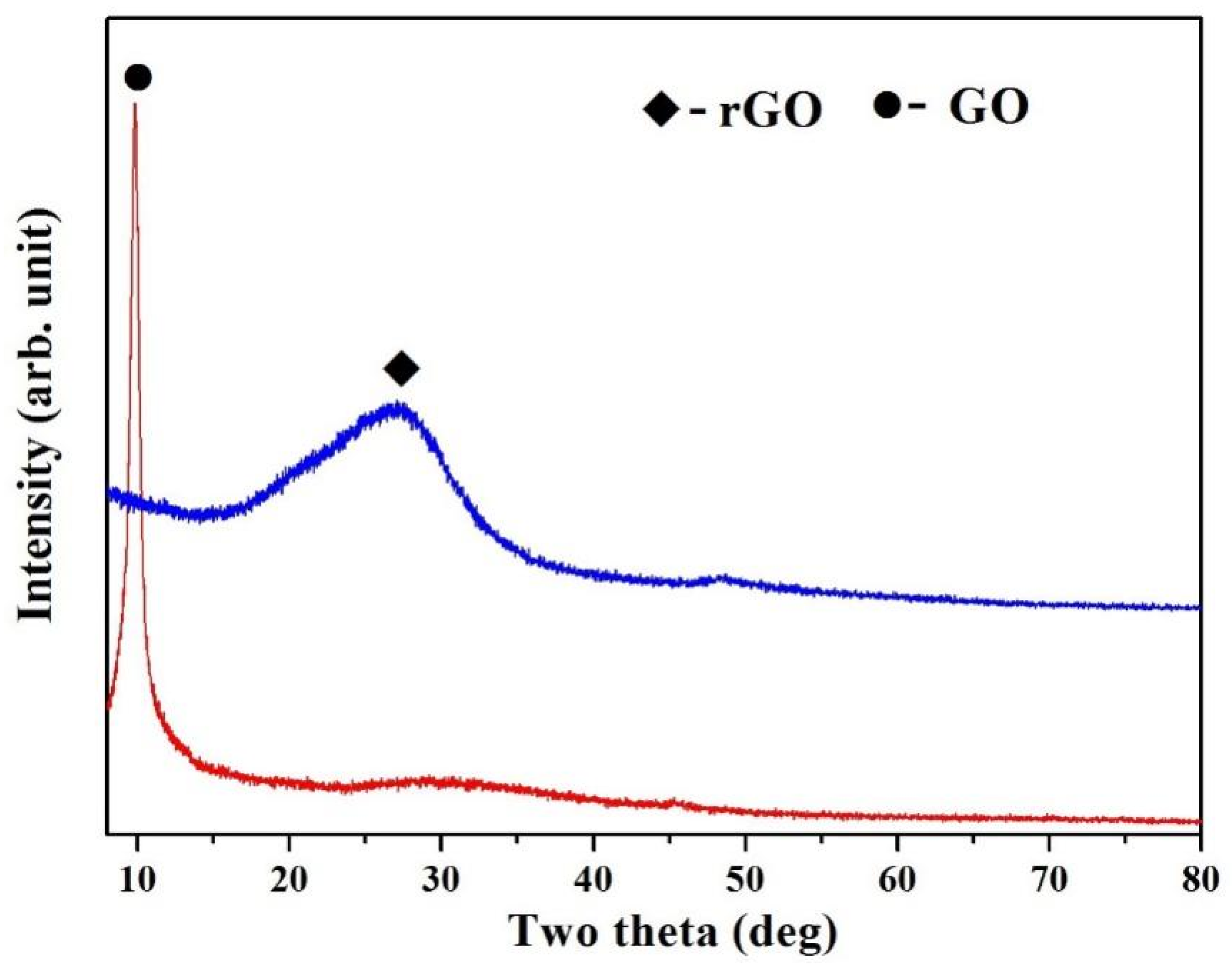



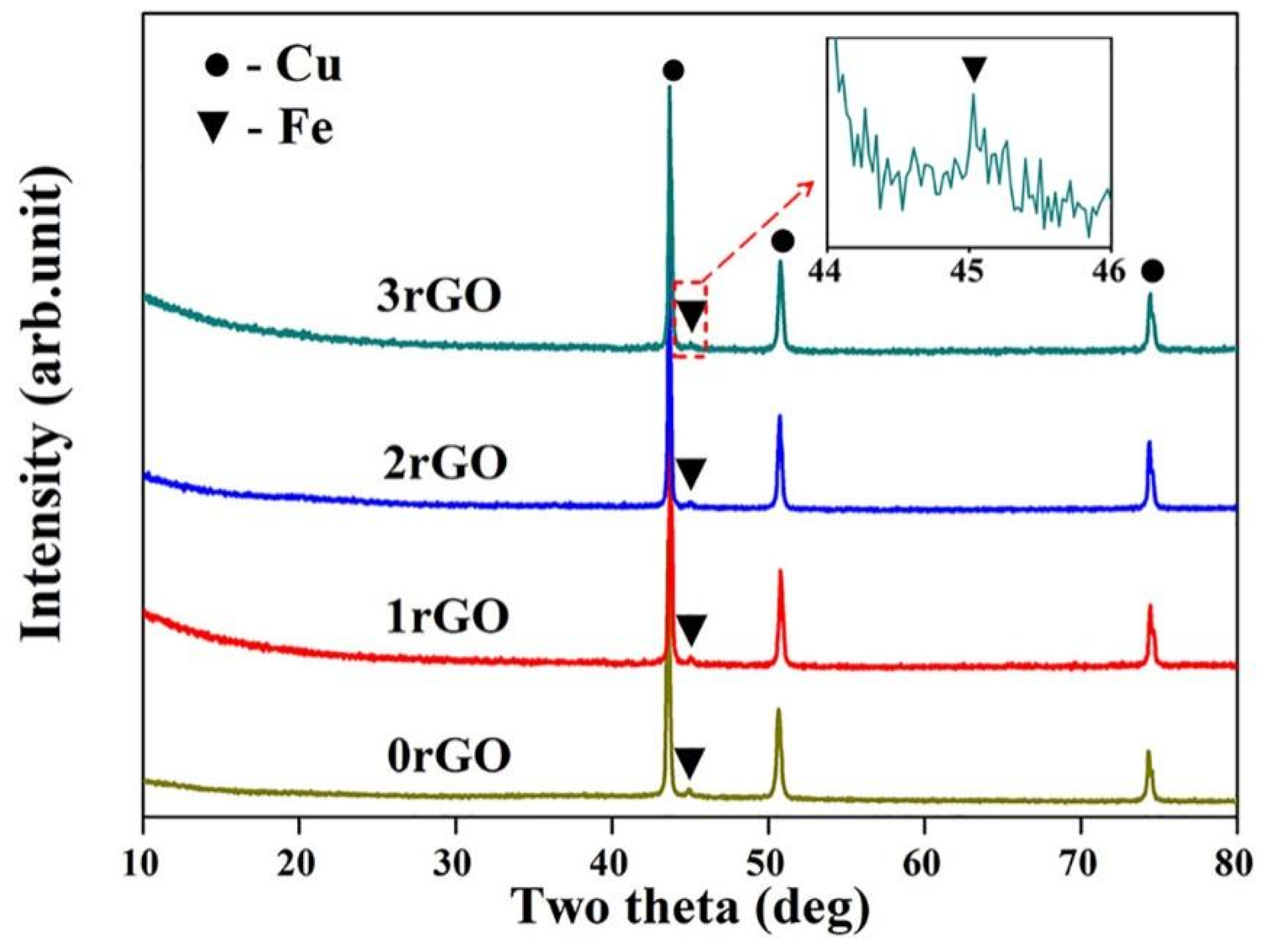

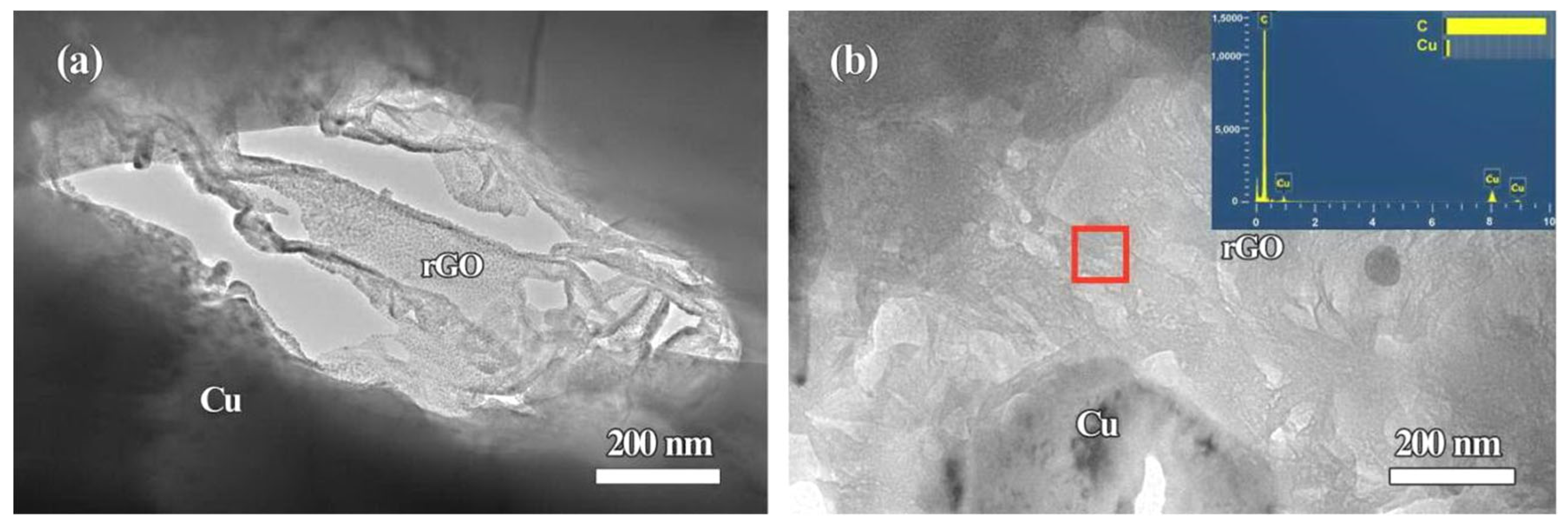
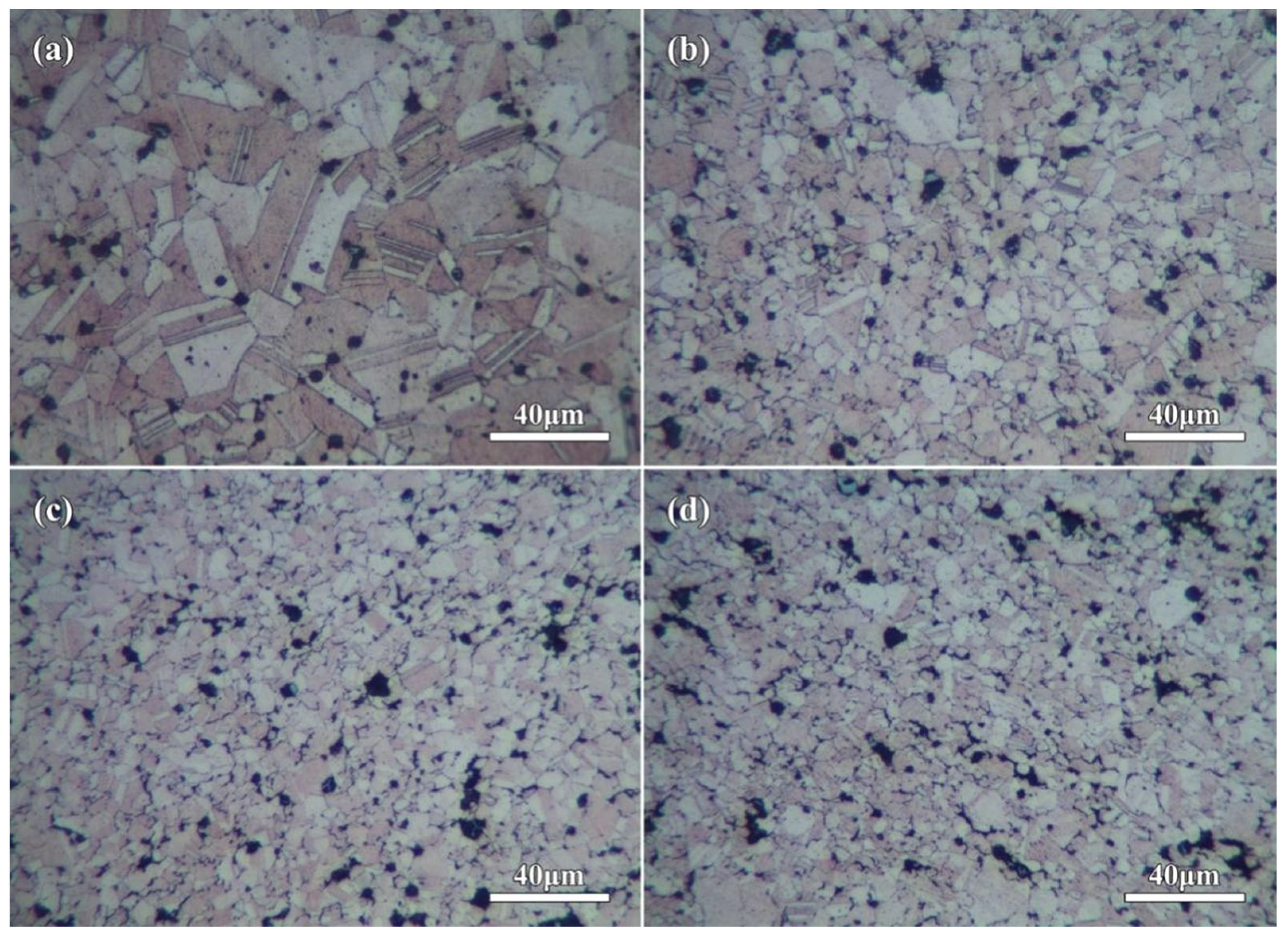
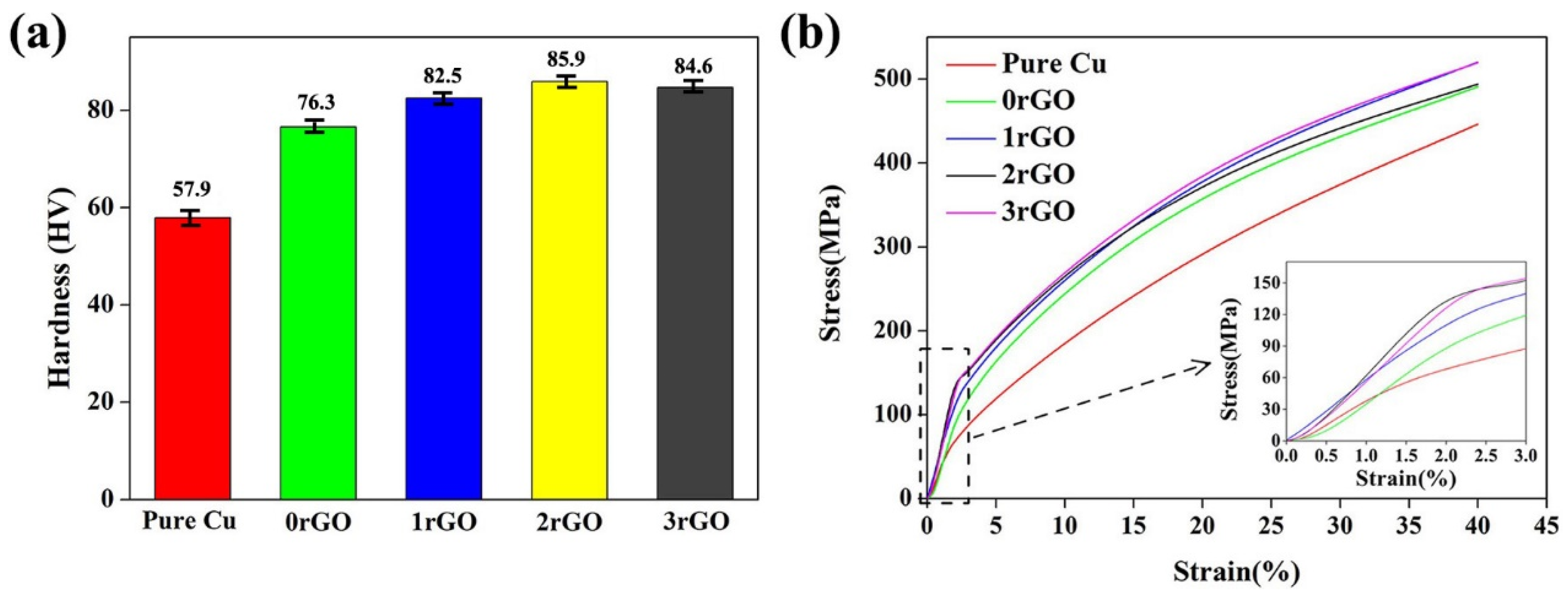

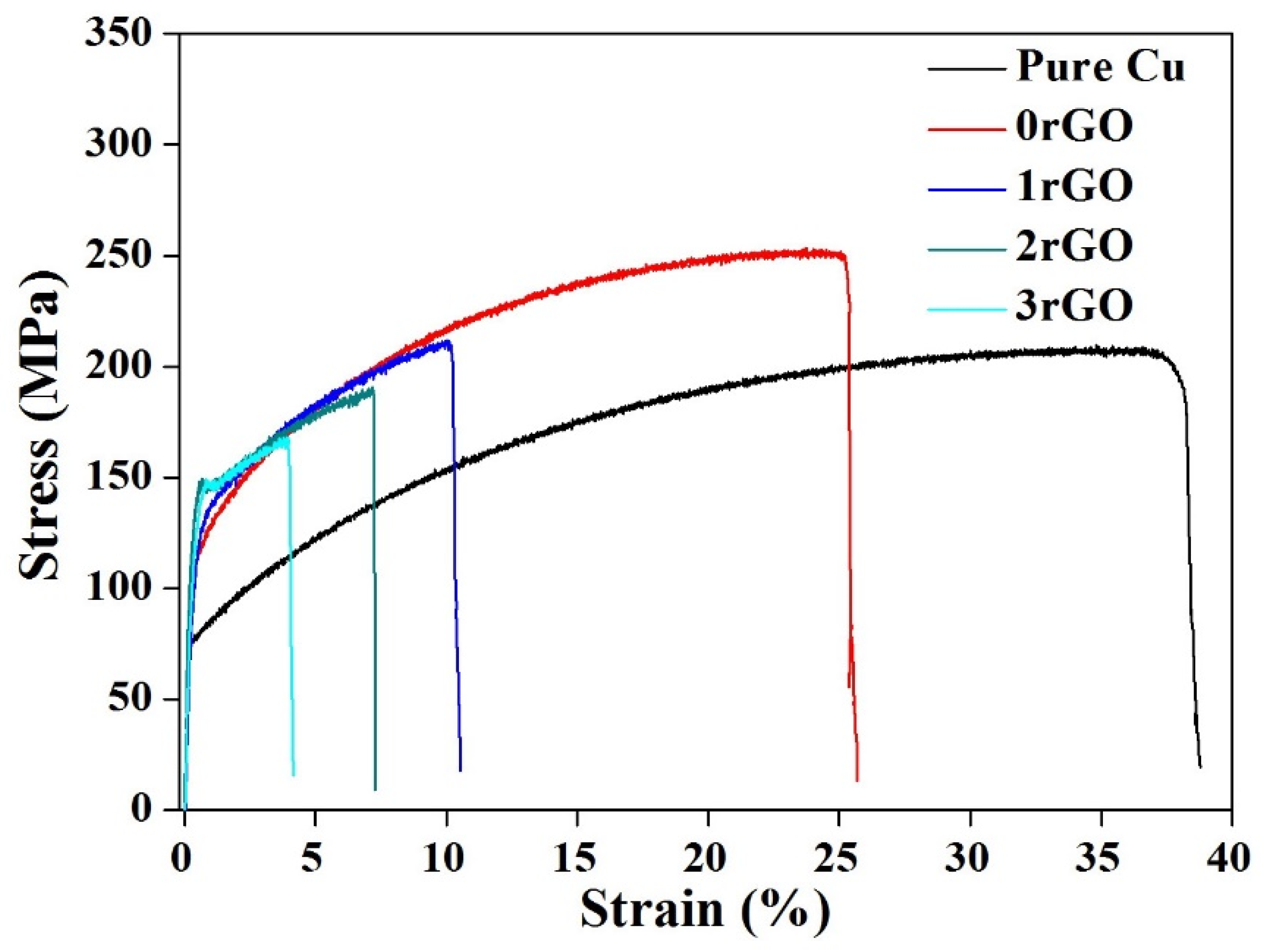
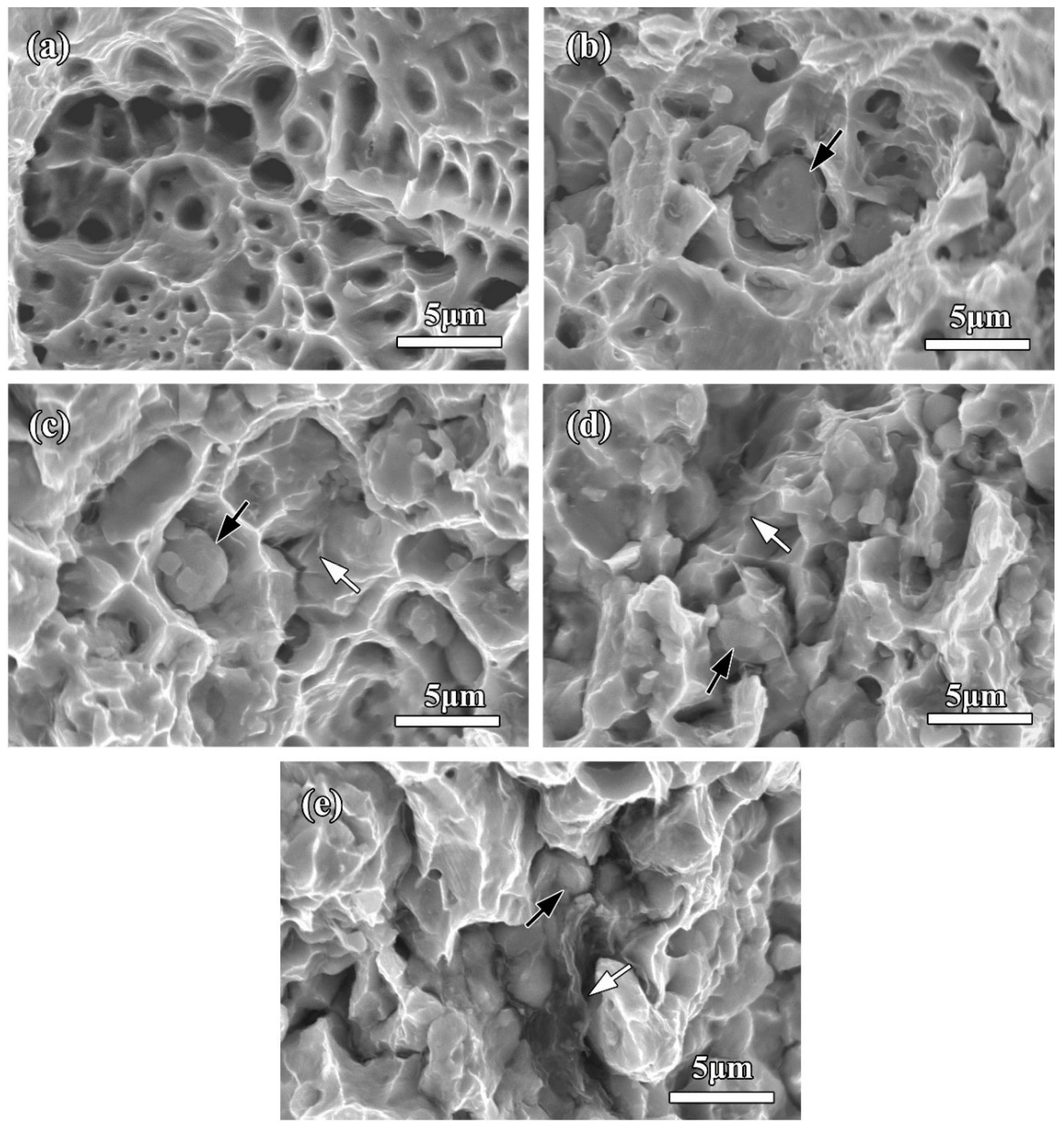
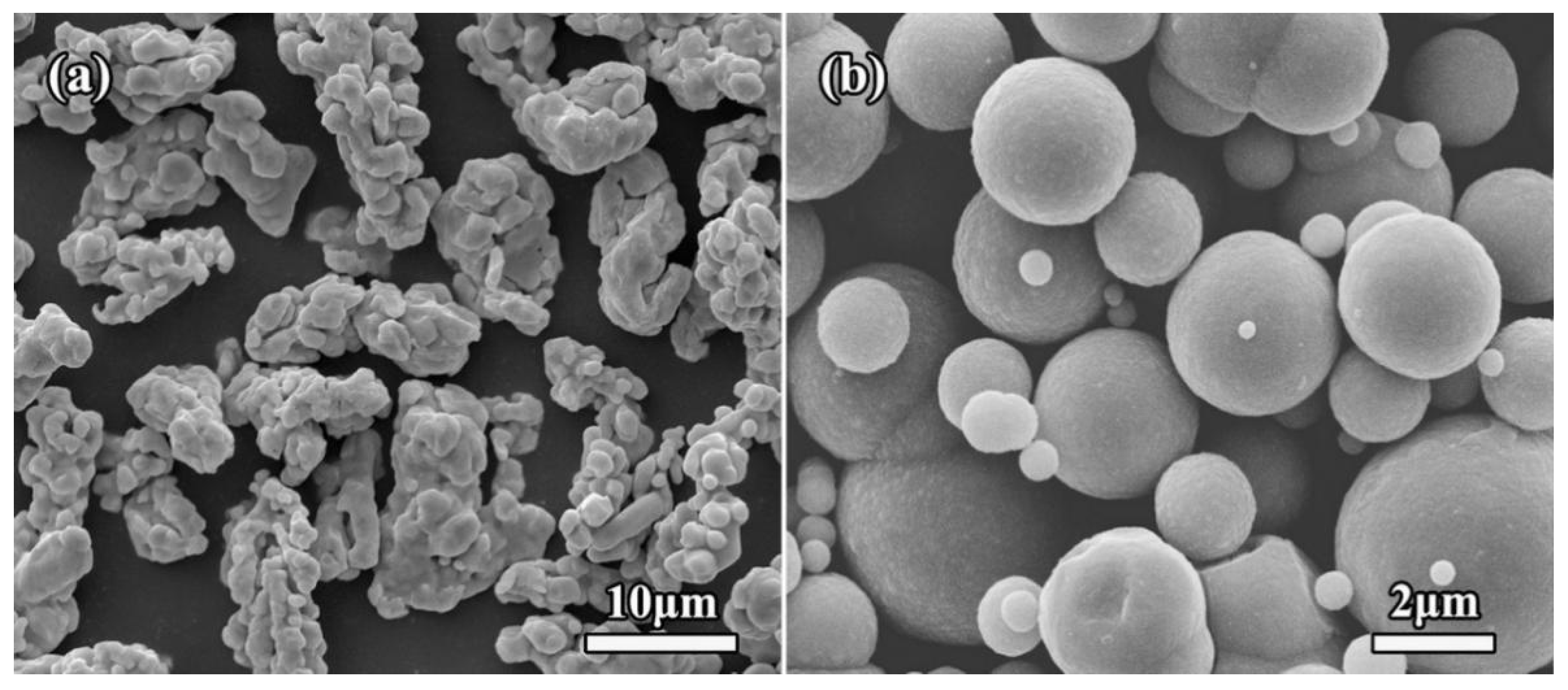
| Reinforcements | Matrix | Reinforcements Content (wt.%) | Electrical Conductivity (%IACS) | Preparation Method | Refs. |
|---|---|---|---|---|---|
| Fe (0rGO) | Cu | 4Fe | 36 | HPS | This work |
| Fe + rGO (1rGO) | Cu | 4Fe + 0.1rGO | 35.3 | HPS | This work |
| Fe + rGO (2rGO) | Cu | 4Fe + 0.2rGO | 34.2 | HPS | This work |
| Fe + rGO (3rGO) | Cu | 4Fe + 0.3rGO | 33.8 | HPS | This work |
| Fe | Cu | 5Fe | 31.0 | HPS + HR | [40] |
| Fe | Cu | 10Fe | 31.2 | Casting | [8] |
| Fe | Cu | 10Fe | 25.8 | Casting + CR | [8] |
| Fe | Cu | 14Fe | ~18 | Casting | [9] |
| Fe | Cu | 8.9Fe | 33.1 | SPS+VHT | [10] |
| Nb | Cu | 13.95Nb | 10 | MA+UHP | [4] |
| Nb | Cu | 7.15Nb | 25 | MA+UHP | [5] |
| Samples | Reinforcements Content | Yield Strength (σ0.2, MPa) | Ultimate Tensile Strength (UTS, MPa) | Elongation (ε, %) | Preparation Method | Refs. |
|---|---|---|---|---|---|---|
| Pure Cu | -- | 76.3 | 207.5 | 37.1 | HPS | This work |
| Fe/Cu (0rGO) | 4Fe (wt.%) | 109.2 | 251.3 | 25.2 | HPS | This work |
| (Fe+rGO)/Cu (1rGO) | 4Fe + 0.1rGO (wt.%) | 113.5 | 210.8 | 10.2 | HPS | This work |
| (Fe+rGO)/Cu (2rGO) | 4Fe + 0.2rGO (wt.%) | 134.8 | 189.8 | 7.2 | HPS | This work |
| (Fe+rGO)/Cu (3rGO) | 4Fe + 0.3rGO (wt.%) | 129.4 | 167.7 | 3.9 | HPS | This work |
| CF/Cu | 0.5CF (wt.%) | 55.3 | 168.7 | 25.7 | HPS | [42] |
| GNPs/Cu | 0.3GNPs (wt.%) | 117 | 172 | 18 | SPS | [32] |
| GNRs/Cu | 0.5GNRs (vol.%) | -- | 184 | 65 | SPS | [43] |
Publisher’s Note: MDPI stays neutral with regard to jurisdictional claims in published maps and institutional affiliations. |
© 2022 by the authors. Licensee MDPI, Basel, Switzerland. This article is an open access article distributed under the terms and conditions of the Creative Commons Attribution (CC BY) license (https://creativecommons.org/licenses/by/4.0/).
Share and Cite
Zhang, X.; He, M.; Zhan, Y.; Yang, W.; Wu, K. Microstructure, Mechanical and Electrical Properties of Hybrid Copper Matrix Composites with Fe Microspheres and rGO Nanosheets. Molecules 2022, 27, 6518. https://doi.org/10.3390/molecules27196518
Zhang X, He M, Zhan Y, Yang W, Wu K. Microstructure, Mechanical and Electrical Properties of Hybrid Copper Matrix Composites with Fe Microspheres and rGO Nanosheets. Molecules. 2022; 27(19):6518. https://doi.org/10.3390/molecules27196518
Chicago/Turabian StyleZhang, Xinjiang, Meng He, Yongzhong Zhan, Wenchao Yang, and Kaifeng Wu. 2022. "Microstructure, Mechanical and Electrical Properties of Hybrid Copper Matrix Composites with Fe Microspheres and rGO Nanosheets" Molecules 27, no. 19: 6518. https://doi.org/10.3390/molecules27196518
APA StyleZhang, X., He, M., Zhan, Y., Yang, W., & Wu, K. (2022). Microstructure, Mechanical and Electrical Properties of Hybrid Copper Matrix Composites with Fe Microspheres and rGO Nanosheets. Molecules, 27(19), 6518. https://doi.org/10.3390/molecules27196518







